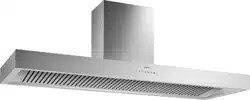Loading ...
Loading ...
Loading ...

6
Installation preparation
9 CAUTION
Ensure that there are no electric wires, gas or
water pipes in the area where holes are to be
made.
Check wall
▯ The walls must be smooth, vertical, and sufficiently
load-bearing.
▯ The depth of the bore holes must be the same
length as the screws. The wall plugs must have a
secure grip.
▯ The enclosed screws and wall plugs are suitable for
solid brickwork. Suitable fasteners must be used
for other structures (e.g. plasterboard, porous
concrete, poroton bricks).
▯ The max. weight of the extractor hood is 132 lbs
(60 kg)
.
General notes
9 WARNING
Risk of death
Risk of poisoning from flue gases that are drawn
back in. The exhaust air must not be conveyed
into a functioning smoke or exhaust gas flue or
into a shaft that is used to ventilate installation
rooms that contain heating appliances. If the
exhaust air is to be conveyed into a non-
functioning smoke or exhaust gas flue, you must
obtain the consent of the heating engineer
responsible.
Exhaust air mode
Note: Ventilation may not exit through an already
operational smoke or exhaust chimney, nor a duct used
for ventilating furnace installation areas.
▯ If the ventilation is intended to pass through a
smoke or exhaust chimney that is not in operation,
the responsible area heating inspector must give
approval.
▯ If the ventilation passes through an external wall,
use a telescope wall sleeve.
Ventilation line
Note: The appliance manufacturer does not assume any
warranty for complaints attributable to the pipe section.
▯ The appliance achieves its optimum performance
with a short, straight exhaust air pipe and as large a
pipe diameter as possible.
▯ As a result of long rough exhaust air pipes, many
pipe bends or pipe diameters that are smaller than
6" (150 mm), the optimum extraction performance is
not achieved and fan noise is increased.
▯ The pipes or hoses for laying the exhaust air line
must be made of non-combustible material.
▯ Use sealing strip for deviating pipe diameters.
▯ An inner diameter of 6" (150 mm), but at least 4¾"
(120 mm), is recommended.
NOTICE: Risk of damage from condensation back flow.
Install exhaust vent at a slight downward slope away
from the appliance (1° slope).
Loading ...
Loading ...
Loading ...
